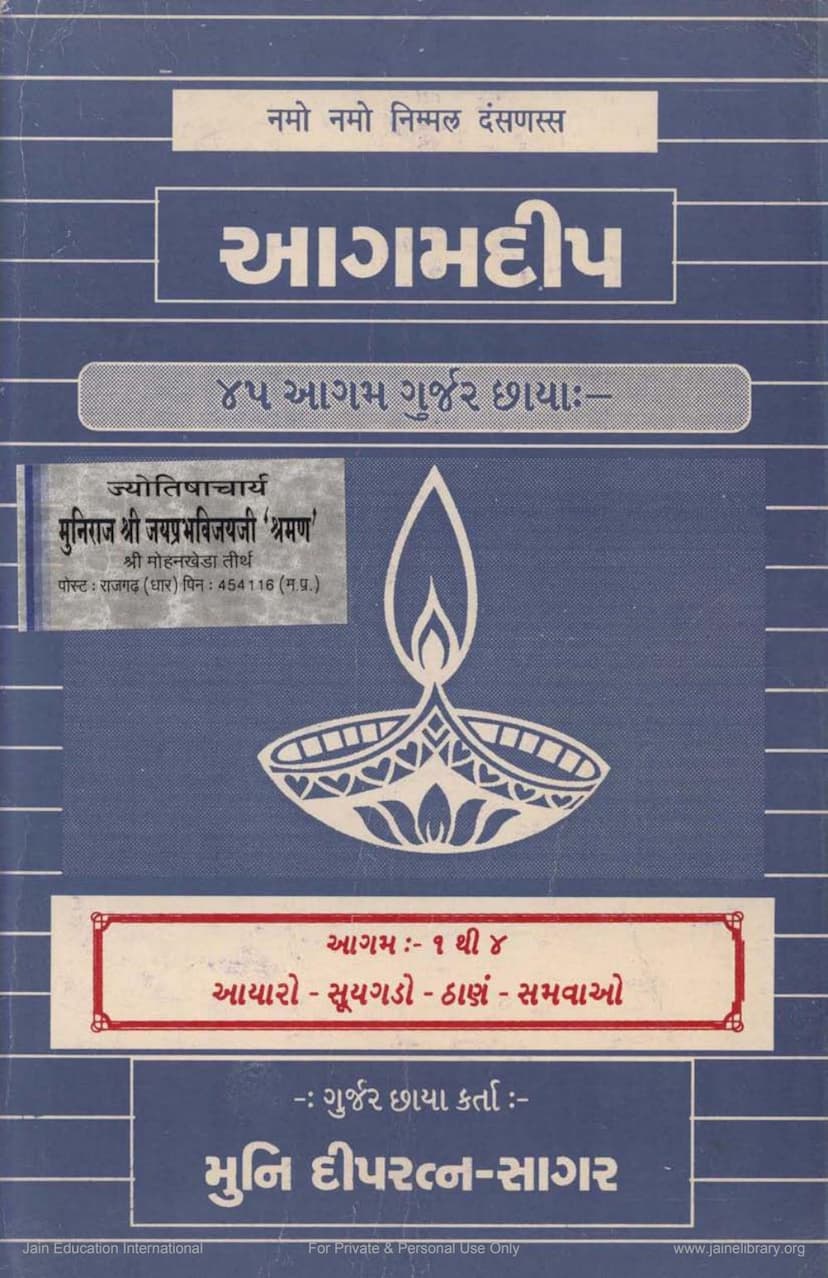Agam Deep 35 Bruhat Kappo Gujarati Anuvaad
Added to library: September 1, 2025

Summary
This document is the Gujarati translation and commentary ("Gurjar Chhaya") of the Jain Agam text Brihad Kappasutra, part of the Agam Deep series published by Agam Shrut Prakashan. The translation and commentary were done by Muni Deepratna Sagar.
Here's a summary of the provided pages:
Overall Purpose:
The "Agam Deep" series aims to make Jain Agam scriptures accessible to Gujarati-speaking readers by providing translations and explanations. This specific volume focuses on the Brihad Kappasutra, which is the second Ched Sutra (a category of Jain scriptures dealing with conduct and discipline). The text is presented in Gujarati, with the commentary being referred to as "Gurjar Chhaya."
Key Information and Content:
- Title: Agam Deep 35 Brihat Kappo Gujarati Anuvaad (Agam Deep 35 Brihad Kappasutra Gujarati Translation)
- Author(s)/Translator: Muni Deepratna Sagar (also referred to as Deepratnasagar).
- Publisher: Agam Shrut Prakashan.
- Content of Brihad Kappasutra: The text primarily deals with the rules and regulations for Jain monks and nuns (Sadhu and Sadhvi). It outlines what is permissible and what is forbidden for them in various situations.
- Structure of the Translation: The text is structured into Udesas (sections) and Sutras (verses/aphorisms). The provided pages cover Udesas 1 through 6, with corresponding page numbers and sutra ranges mentioned.
- Nature of the Commentary ("Gurjar Chhaya"): The commentary provides explanations and interpretations of the original sutras. It often clarifies the meaning of specific terms, elaborates on the reasoning behind the rules, and sometimes offers different possible interpretations based on traditional commentaries.
- Specific Rules Discussed (Examples from the text):
- Fruits: Rules regarding the consumption of fruits like mangoes and bananas, whether they should be whole or cut, and the conditions under which they can be taken.
- Residential Rules (Upashraya): Detailed regulations about where monks and nuns can reside, including restrictions on certain types of locations (e.g., near markets, at crossroads, with certain architectural features), and conditions for staying in villages, towns, and rural areas, especially during different seasons.
- Food and Drink: Rules concerning the acceptance and consumption of food and drink, including those that are mixed or prepared by others.
- Possessions: Regulations on the types of clothing, begging bowls (patra), and dust-removing whisks (rajoharan) that monks and nuns can possess and use.
- Interactions: Rules governing interactions with lay people, other religious practitioners, and even within the monastic community itself.
- Prohibited Actions: The text enumerates many actions that are forbidden for monks and nuns, often with explanations of why they are considered problematic (e.g., leading to attachment, causing doubt, violating vows).
- Penances and Expiations: Mention of various penances and expiations (prayaschitta) that are incurred for violating the rules.
- Exceptions and Permissions: The text often provides exceptions or specific conditions under which certain rules might be relaxed or different practices are allowed.
- Gender-Specific Rules: A significant portion of the text differentiates rules for male monks (Sadhu) and female nuns (Sadhvi), often due to considerations of chastity and vulnerability.
- Social and Environmental Factors: Rules consider the context of the environment, the presence of people, and social conditions.
Key Themes and Principles:
- Discipline and Restraint: The Kappasutra is fundamental for establishing and maintaining strict discipline within the Jain monastic order.
- Non-violence (Ahimsa): Many rules are derived from the principle of not harming living beings, including subtle aspects of conduct.
- Celibacy (Brahmacharya): A significant focus is on safeguarding the chastity and purity of the monks and nuns.
- Detachment (Aparigraha): Rules about possessions and consumption aim to foster detachment from worldly things.
- Austerity (Tapas): The text implicitly supports and guides the practice of austerity.
- Protection of the Order: The rules are designed to maintain the integrity, reputation, and spiritual progress of the monastic community.
Sponsorship and Publication Details:
The text highlights financial contributors ("Dravya Sahayak") who supported the publication of the "Agam Deep" series, demonstrating the community's commitment to preserving and disseminating Jain scriptures. Various individuals and organizations are credited for their support.
Overall, this volume is a detailed guide to the ascetic conduct and disciplinary rules for Jain monks and nuns as expounded in the Brihad Kappasutra, made accessible through a Gujarati translation and commentary. It offers insights into the rigorous lifestyle and the practical application of Jain principles in the daily lives of ascetics.